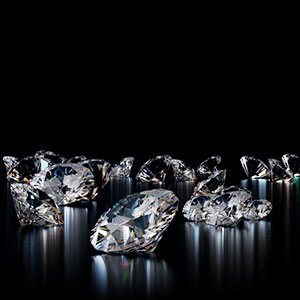
During a July 2020 webinar, Andrey Zharkov, the former Alrosa president who now heads lab-grown venture Ultra C, made a bold prediction: Lab-grown diamonds would soon be valued on a “cost-plus” model.
“In two or three years, we will see more pricing for laboratory-grown diamonds based on benchmarking,” he said.
Nearly three years later, that hasn’t happened, but an increasing number of people in the lab-grown space want it to.
Marty Hurwitz, CEO of MV Marketing and a lab-grown consultant, recently published a “manifesto” arguing the industry should stop pricing its items based on the Rapaport list. (According to MV research, 57% of lab-grown sellers use the Rap list for every sale.) Joanna Park-Tonks, the new head of the International Grown Diamond Association, has said the same.
It makes sense to go “off Rap.” The lab-grown trade has a different supply-demand profile, and different market dynamics, than the natural business. It also devalues the product when lab-grown diamonds are sold for more than 95% off the Rapaport list. On top of that, the list’s namesake, Martin Rapaport, is a vituperative critic of lab-grown.
However, if the experiences of the natural industry are any guide, the lab-grown industry will have a difficult time weaning itself off the list. It has almost become a pattern: Whenever natural diamond prices drop—and lately lab-grown prices have dropped sharply—dealers complain about the list and seek alternatives. They even write manifestos. And, in the end, they come back.
Why? For one, Rapaport and his team are plugged into the market. Some prefer the Rap sheet’s opacity and complexity to a more straightforward list. But the most likely answer is habit. The trade needs both a source of price information and universal language. For decades, that’s been Rap.
The created-gem business claims to be about bucking tradition. Getting “off Rap” shouldn’t be hard. Hurwitz has proposed that, since “lab-grown diamonds aren’t grown in as many colors and clarities as mined diamonds,” the industry should set up a web portal, where growers anonymously enter prices once a week. That would generate an aggregated list. (Another, perhaps more scientific, way to do this would be to use transaction data from online exchanges or e-tail sites.) If they prefer, companies could offer stones using both the Rap and other lists. Eventually, traders will favor one or the other.
If the lab-grown business is truly rethinking how it’s pricing gems, it might also take the opportunity to move away from another complicated legacy system used by the trade: the GIA grading scale.
The biggest argument for created diamonds goes like this: Examine two gems side by side. Except for lab-growns with noticeable tinges caused by treatment—a not-insignificant part of the business—it’s usually impossible to tell one from the other. So why should one be more desirable than the other? Why is one more valuable?
On the other hand, if you show people a D and E diamond, or a VS1 or a VS2, most people can’t tell the difference either. Yet, one is still worth more than the other, and the lab-grown industry has no problem with that. A truly useful grading scale would be based on visual distinctions that can be spotted by consumers, not just gemologists with microscopes.
The man-made industry is far more tech-oriented than the traditional diamond business. With a little algorithmic tinkering—possibly guided by artificial intelligence—it shouldn’t be impossible to develop a better way to rank clarity, cut, and color than a 69-year-old legacy scale. It might even tackle the tinge problem. These new ratings could be offered alongside the standard grades. And again, eventually one system will be preferred over the other.
There’s a precedent for this. In the 1990s, when Hurwitz’s company began promoting champagne (brown) diamonds for the Argyle mine, it introduced a proprietary color scale: C1 through C7. That scale isn’t used much now, but it gave the product a point of differentiation, a novelty that set it apart. Until it shut down, Argyle offered two reports at its pink tenders—one from Argyle based on its own scale, the other from GIA. The U.S. market favored the GIA grades, execs told me, while overseas markets were more interested in Argyle’s.
If a new scale is truly useful, even the natural industry might adopt it. Which would be an impressive switch—the natural industry imitating the lab-grown.
For now, of course, most of the lab market’s strides have been on the back of the natural industry. Instead of trying to develop a new consumer segment, growers have mostly targeted the established engagement ring market. Plus, they use the Rap list and GIA’s 4Cs scale. For a sector that bristles at the word imitation, it all feels a bit imitative—not to mention lazy.
By following the patterns set by the natural industry, the lab-grown business has found itself with a similar set of problems, including a commoditized product, decreasing margins, and prices dictated mostly by online sellers and low-wage countries. We hear some growers are finding profits so squeezed, they are increasing direct-to-consumer (D2C) efforts. (Many already sell D2C. Some are open about it, others aren’t.)
The lab-grown business needs to become its own industry. For the moment, it not only apes the natural business, some companies have an unhealthy obsession with bringing it down. It’s not just harping on mines’ eco-impact—while almost always omitting their own. Whenever something awful happens at a diamond mine, lab companies produce a flurry of LinkedIn posts celebrating these human tragedies with a joy that feels like Christmas.
Yet, considering that lab-grown prices are based on the Rap list—and the two industries are intertwined—this makes little sense as a long-term strategy. But maybe some of these companies don’t care about the long term.
It’s no secret some tech-oriented growers view lab-grown gems as a quick money-raising ploy, which will allow them to develop synthetic diamonds for industrial purposes. (It’s not clear how well that’s worked.) These growers don’t care about the health of the jewelry business. They didn’t grow up in it; they have little interest in sticking around. Some Indian producers also see lab-grown as a fad. And just as they rushed to enter the industry, some are now rushing to get out.
That’s caused some in the lab-grown diamond business to admit it’s time to change course. The modern lab-grown trade is only a few years old. It has a chance to do something new and interesting and different. So far, it mostly hasn’t. And so far, that’s mostly worked.
But, as the saying goes, nothing lasts forever. Lately, the ride-sharing, social media, video streaming, crypto, e-commerce, and delivery app sectors have faced serious reckonings, following long periods of seemingly unstoppable growth.
Some of these businesses stemmed from innovative ideas. But, they often had flawed business models, built on what’s called “counterfeit capitalism.” Venture capital cash fueled their rapid expansion, but they didn’t have much of a plan beyond that. They caused havoc in their respective industries, as they were meant to. But they’ve had a tough time rising from the wreckage. That could start to happen to lab-grown. Some think it already has.
Photo: Getty Images
- Subscribe to the JCK News Daily
- Subscribe to the JCK Special Report
- Follow JCK on Instagram: @jckmagazine
- Follow JCK on X: @jckmagazine
- Follow JCK on Facebook: @jckmagazine






